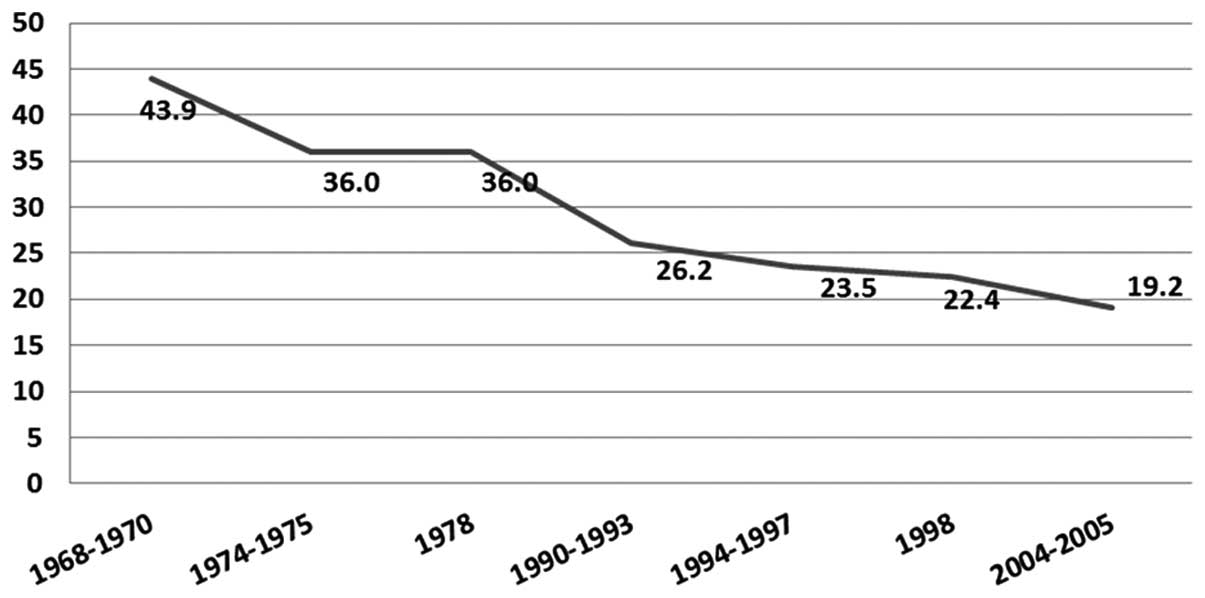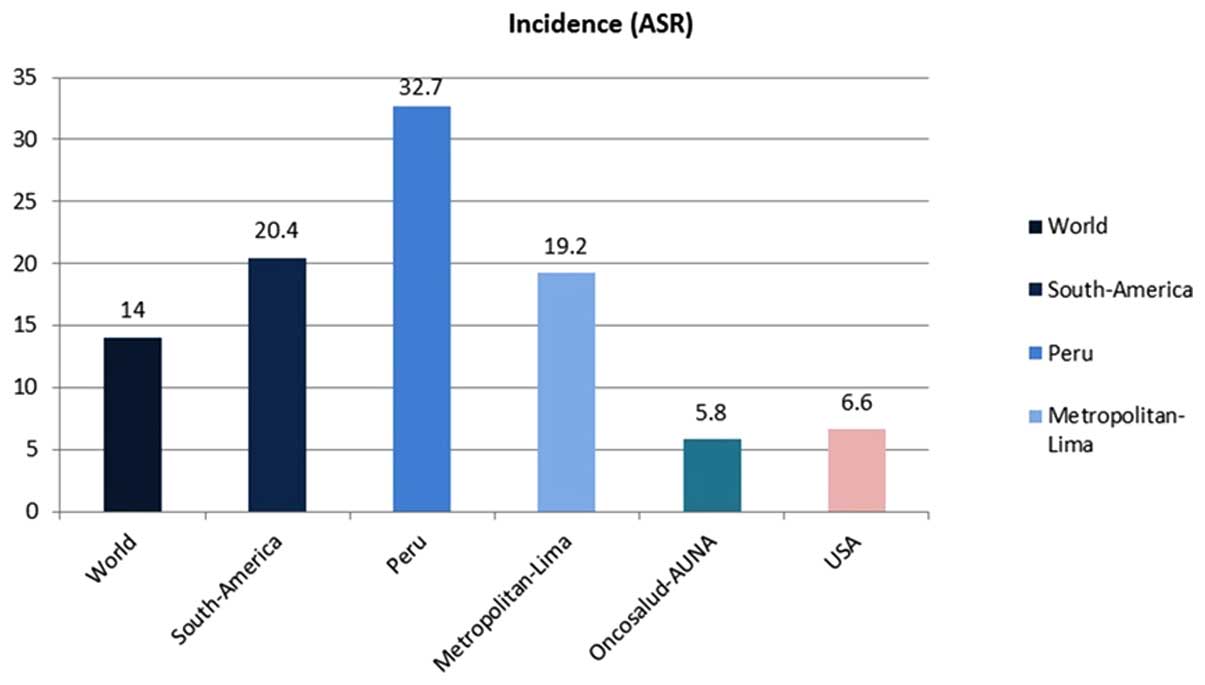|
1
|
Ferlay J, Soerjomataram I, Ervik M,
Dikshit R, Eser S, Mathers C, et al: GLOBOCAN 2012 v1.0. cancer
incidence and mortality worldwide: IARC Cancer Base No. 11
[Internet]. Lyon, France: International Agency for Research on
Cancer. 2013.http://globocan.iarc.frAccessed. July
01–2015
|
|
2
|
Cancer Registry of Metropolitan Lima.
2014.
|
|
3
|
Albújar PF: Cancer in Trujullo, 1996–2002:
Incidence and mortality. Population Cancer Registry of Areguipa
(Perú). 2006.
|
|
4
|
Ministerio de Salud: Registro de cáncer
poblacional de arequipa. Perú. Arequipa: Instituto Regional de
Enfermedades Neoplásicas del Sur. 2011.
|
|
5
|
Halec G, Alemany L, Lloveras B, Schmitt M,
Alejo M, Bosch FX, Tous S, Klaustermeier JE, Guimerà N, Grabe N, et
al: Pathogenic role of the eight probably/possibly carcinogenic HPV
types 26, 53, 66, 67, 68, 70, 73 and 82 in cervical cancer. J
Pathol. 234:441–451. 2014. View Article : Google Scholar : PubMed/NCBI
|
|
6
|
de Sanjose S, Quint WG, Alemany L, Geraets
DT, Klaustermeier JE, Lloveras B, Tous S, Felix A, Bravo LE, Shin
HR, et al: Human papillomavirus genotype attribution in invasive
cervical cancer: A retrospective cross-sectional worldwide study.
Lancet Oncol. 11:1048–1056. 2010. View Article : Google Scholar : PubMed/NCBI
|
|
7
|
Alemany L, de Sanjosé S, Tous S, Quint W,
Vallejos C, Shin HR, Bravo LE, Alonso P, Lima MA, Guimerà N, et al:
Time trends of human papillomavirus types in invasive cervical
cancer, from 1940 to 2007. Int J Cancer. 135:88–95. 2014.
View Article : Google Scholar : PubMed/NCBI
|
|
8
|
Santos C, Muñoz N, Klug S, Almonte M,
Guerrero I, Alvarez M, Velarde C, Galdos O, Castillo M, Walboomers
J, et al: HPV types and cofactors causing cervical cancer in Peru.
Br J Cancer. 85:966–971. 2001. View Article : Google Scholar : PubMed/NCBI
|
|
9
|
Almonte M, Ferreccio C, Gonzales M,
Delgado JM, Buckley CH, Luciani S, Robles SC, Winkler JL, Tsu VD,
Jeronimo J, et al: Risk factors for high-risk human papillomavirus
infection and cofactors for high-grade cervical disease in Peru.
Int J Gynecol Cancer. 21:1654–1663. 2011. View Article : Google Scholar : PubMed/NCBI
|
|
10
|
Iwasaki R, Galvez-Philpott F, Arias-Stella
J Jr and Arias-Stella J: Prevalence of high-risk human
papillomavirus by cobas 4800 HPV test in urban Peru. Braz J Infect
Dis. 18:469–472. 2014. View Article : Google Scholar : PubMed/NCBI
|
|
11
|
Bautista F, Vallejos C, Bances G, Galdos O
and Santos C: Prevalence ofcervical and HPV infection in women of
the “Milk Glass” comitee in Surquillo District. Carcinos. 1:3–9.
2013.
|
|
12
|
Montano SM, Hsieh EJ, Calderón M, Ton TG,
Quijano E, Solari V and Zunt JR: Human papillomavirus infection in
female sex workers in Lima, Peru. Sex Transm Infect. 87:81–82.
2011. View Article : Google Scholar : PubMed/NCBI
|
|
13
|
Brown B, Blas MM, Cabral A, Carcamo C,
Gravitt PE and Halsey N: Oral sex practices, oral human
papillomavirus and correlations between oral and cervical human
papillomavirus prevalence among female sex workers in Lima, Peru.
Int J STD AIDS. 22:655–658. 2011. View Article : Google Scholar : PubMed/NCBI
|
|
14
|
Vallejos C: National plan for prevention,
early detection, and cancer control in Peru. Am Soc Clin Oncol Educ
Book. 2013. View Article : Google Scholar : PubMed/NCBI
|
|
15
|
National Cancer Institute of Peru. Main
results of ‘Hope Plan’. 2014.http://www.inen.sld.pe/portal/documentos/pdf/institucional/Memoria/19052015_PRINCIPALES%20RESUL%20%20DEL%20INEN%20%20PARA%20PLAN%20ESPERANZA%20Diciembre%202014%2020012015.pdfAccessed.
August 11–2015
|
|
16
|
Medrano MM: Sociocultural and
psychological factors that influence the decision of users for
taking Pap smear. Carlos Cueto Fernandini health center. Year 2014.
Thesis. Faculty of Obstetrics. Universidad Nacional Mayor de San
Marcos.
|
|
17
|
Winkler JL, Lewis K, Del Aguila R,
Gonzales M, Delgado JM, Tsu VD and Sellors JW: Is magnification
necessary to confirm visual inspection of cervical abnormalities? A
randomized trial in Peru. Rev Panam Salud Publica. 23:1–6. 2008.
View Article : Google Scholar : PubMed/NCBI
|
|
18
|
Zevallos L, Pastor R and Moscoso B: Supply
and demand of medical specialists in the health facilities of the
ministry of health: National, regional and by type of specialty
gaps. Rev Peru Med Exp Salud Publica. 28:177–185. 2011.(In
Spanish). View Article : Google Scholar : PubMed/NCBI
|
|
19
|
Elias M and Rey S: Educational performance
and spatial convergence in Peru. Région et Développement.
33:107–135. 2011.
|
|
20
|
Paz Soldan VA, Lee FH, Carcamo C, Holmes
KK, Garnett GP and Garcia P: Who is getting Pap smears in urban
Peru? Int J Epidemiol. 37:862–869. 2008. View Article : Google Scholar : PubMed/NCBI
|
|
21
|
Belinson JL, Du H, Yang B, Wu R, Belinson
SE, Qu X, Pretorius RG, Yi X and Castle PE: Improved sensitivity of
vaginal self-collection and high-risk human papillomavirus testing.
Int J Cancer. 130:1855–1860. 2012. View Article : Google Scholar : PubMed/NCBI
|
|
22
|
Abuelo CE, Levinson KL, Salmeron J,
Sologuren CV, Fernandez MJ and Belinson JL: The Peru cervical
cancer screening study (PERCAPS): The design and implementation of
a mother/daughter screen, treat, and vaccinate program in the
Peruvian jungle. J Community Health. 39:409–415. 2014. View Article : Google Scholar : PubMed/NCBI
|
|
23
|
Levinson KL, Abuelo C, Chyung E, Salmeron
J, Belinson SE, Sologuren CV, Ortiz CS, Vallejos MJ and Belinson
JL: The Peru cervical cancer prevention study (PERCAPS):
Community-based participatory research in Manchay, Peru. Int J
Gynecol Cancer. 23:141–147. 2013. View Article : Google Scholar : PubMed/NCBI
|
|
24
|
Barrionuevo-Rosas L, Palència L and
Borrell C: How does type of health insurance affect receipt of Pap
testing in Peru? Rev Panam Salud Publica. 34:393–400. 2013.(In
Spanish). PubMed/NCBI
|
|
25
|
Levinson KL, Abuelo C, Salmeron J, Chyung
E, Zou J, Belinson SE, Wang G, Ortiz CS, Vallejos CS and Belinson
JL: The Peru cervical cancer prevention study (PERCAPS): The
technology to make screening accessible. Gynecol Oncol.
129:318–323. 2013. View Article : Google Scholar : PubMed/NCBI
|
|
26
|
Widdice LE, Bernstein DI, Leonard AC,
Marsolo KA and Kahn JA: Adherence to the HPV vaccine dosing
intervals and factors associated with completion of 3 doses.
Pediatrics. 127:77–84. 2011. View Article : Google Scholar : PubMed/NCBI
|
|
27
|
Penny M, Bartolini R, Mosqueira NR,
LaMontagne DS, Mendoza MA, Ramos I, Winkler JL, Villafana J,
Janmohamed A and Jumaan AO: Strategies to vaccinate against cancer
of the cervix: Feasibility of a school-based HPV vaccination
program in Peru. Vaccine. 29:5022–5030. 2011. View Article : Google Scholar : PubMed/NCBI
|
|
28
|
Fregnani JH, Carvalho AL, Eluf-Neto J,
Ribeiro Kde C, Kuil Lde M, da Silva TA, Rodrigues SL, Mauad EC,
Longatto-Filho A and Villa LL: A school-based human papillomavirus
vaccination program in barretos, Brazil: Final results of a
demonstrative study. PLoS One. 8:e626472013. View Article : Google Scholar : PubMed/NCBI
|
|
29
|
Bartolini RM, Winkler JL, Penny ME and
LaMontagne DS: Parental acceptance of HPV vaccine in Peru: A
decision framework. PLoS One. 7:e480172012. View Article : Google Scholar : PubMed/NCBI
|
|
30
|
Gutiérrez-Aguado A: Cost-utility of the
vaccine against the human papiloma virus in peruvian women. Rev
Peru Med Exp Salud Publica. 28:416–425. 2011.(In Spanish).
View Article : Google Scholar : PubMed/NCBI
|
|
31
|
Ministry of Health of Peru. Press Note.
http://www.minsa.gob.pe/?op=51¬a=16252Accessed.
August 05–2015
|
|
32
|
Ministry of Economy and Finance of Peru.
Economic transparency. http://apps5.mineco.gob.pe/transparency/Browser/Navegar.aspxAccessed.
March 11–2016
|












